Yves GARY Hits: 5866
Category: 1851 : THE £100 cup
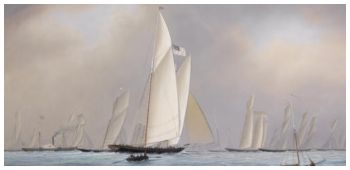 The new rules :
The new rules :The RYS Minutes of 9 May 1851 record the decision to hold a race on Friday 22nd August, during the club's Regatta, which would be open to yachts of clubs of all nations. This first such race was arranged so that America could take part if she came to England. Squadron races were normally open only to their own yachts.
In 1845 a £50 cup was offered for a race by vessels under 30 tons belonging to any 'regularly established yacht club'. There was another in 1846 for yachts of 'any other Royal Yacht Club' but the practice had not been continued.
The cards containing the names and colors of the yachts describe the course merely as being «round the Isle of Wight' the printed programme stated that it was to be «round the Isle of Wight, inside Norman's buoy and Sandhead buoy, and outside the Nab.' Race card and race instructions apparently differed, one just saying Round the Isle of Wight while the other contained the normal Queen's Course instruction to round the Nab.
Source: The Lawson history of the America's Cup: a record of fifty years
Winfield M. Thompson, Thomas W. Lawson - Google Livres
In addition to the schooner America, 17 British yachts were registered :
| Yacht | Class | Tonn. | Designer/Builder | Yard | Year | Owners |
| Alarm | Cotre | 193 | Thomas Inman | Lymington | 1830 | Joseph Weld |
| Arrow | Cotre | 84 | Thomas Inman | Lymington | 1821 | Thomas Chamberlayne |
| Aurora | Cotre | 47 | Michael Ratsey | Cowes | 1838 | Thomas Le Marchant |
| Bacchante | Cotre | 80 | Thomas and James Manlaws Wanhill | Poole | 1847 | Benjamin Heywood Jones |
| Beatrice | Goélette | 117 | Camper | 1851 | Sir Walter P Carew | |
| Brilliant | Goélette 3 mâts | 393 | John Rubie | Southampton | 1839 | George Holland Ackers |
| Constance | Goélette | 136 | Joseph White | East Cowes | 1851 | Marquis of Conyngham |
| Eclipse | Cotre | 50 | Thomas and James Manlaws Wanhill | Poole | 1847 | Henry Samuel Fearon |
| Fernande | Goélette | 127 | William Camper | Gosport | Major Francis Mountjoy Martyn | |
| Freak | Goélette | 60 | Thomas and James Manlaws Wanhill | Poole | 1849 | William Curling Esq |
| Gipsy Queen | Goélette | 99 | Joseph White | East Cowes | 1848 | Sir Henry Bold Hoghton |
| Ione | Goélette | 57 | Joseph White | East Cowes | 1851 | Almon Hill |
| Mona | Cotre | 56 | Richard Pinney | Poole | 1846 | Lord Alfred Paget |
| Stella | Cotre | 39 | George & James Inman | Lymington | 1851 | Mr Richard Frankland |
| Titania | Goélette | 100 | Robinson and Russell | Millwall | 1850 | Mr R. Stephenson |
| Volante | Cotre | 48 | Harvey | Ipswich | 1851 | J L Craigie |
| Wyvern | Goélette | 127 | Camper | 1845 | Duke of Marlborough |
Most of the yachts were on the RYS List, but a few belonged to members of other clubs such as Henry Fearon who was a member of the Royal Western and the Royal St George. Volante's owner belonged to the former and also to the Royal Thames and the Royal London. The owners of several of the yachts, even if members of the RYS, were also prominent in other clubs. The entrants for the race that day included the yachts of the Commodores of the Royal Victoria, the Royal Thames and the Royal St George and Vice Commodores of the Royal Victoria, Royal Welsh and Royal Mersey. So America was pitted against the yachts of many of the most prominent sailing men of the day.
 'In the memory of man Cowes never presented such an appearance as upon this day. There must have been at least a hundred yachts lying at anchor in the Roads; the beach was crowded from Egypt to the piers, the esplanade in front of the Club thronged with ladies and gentlemen, and with the people inland, who came over in shoals with wives, sons and daughters for the day. Booths were erected all along the quay and the roadstead was alive with boats, while from the sea and shore rose an incessant buzz of voices, mingled with the splashing of oars, the flapping of sails, and the hissing of steam, from the excursion vessels preparing to accompany the race… It was with the greatest difficulty the little town gave space enough to the multitudes that came from all quarters to witness an event so novel and so interesting, and the hotels were quite inadequate to meet the demand of their guests' ...
'In the memory of man Cowes never presented such an appearance as upon this day. There must have been at least a hundred yachts lying at anchor in the Roads; the beach was crowded from Egypt to the piers, the esplanade in front of the Club thronged with ladies and gentlemen, and with the people inland, who came over in shoals with wives, sons and daughters for the day. Booths were erected all along the quay and the roadstead was alive with boats, while from the sea and shore rose an incessant buzz of voices, mingled with the splashing of oars, the flapping of sails, and the hissing of steam, from the excursion vessels preparing to accompany the race… It was with the greatest difficulty the little town gave space enough to the multitudes that came from all quarters to witness an event so novel and so interesting, and the hotels were quite inadequate to meet the demand of their guests' ...
18 yachts entered, 15 starters. At 9.55 the preparatory gun was fired from the Club-house battery, and the yachts were soon sheeted from deck to topmast with clouds of canvas, huge gafF-topsails and balloon-jibs being greatly in vogue, and the America evincing her disposition to take advantage of her new jili by hoisting it with all alacrity. The whole flotilla not in the race were already in motion, many of them stretching down towards Osborne and Ryde to get good start of the clippers. Of the list above given the Titania and the Stella did not start, and the Fernande did not take her station (the latter was twice winner in 1850, and once this year ; the Stella won once last year). Thus only fifteen started, of which seven were schooners, including the Brilliant (three-masted schooner), and eight were cutters.
Times off
No Man's Land buoy
1. Volante 11:07:00
2. Freak 11:08:20
3. Aurora 11:08:30
4. Gipsy Queen 11:08:45
5. America 11:09:0
6. Beatrice 11:09:15
7. Alarm 11:09:20
8. Arrow 11:10:0
9. Bacchante 11:10:15
Abandon : Wyvern
At 10 o'clock the signal gun for sailing was fired, and before the smoke had well cleared away the whole of the beautiful fleet was under way, moving steadily to the east with the tide and a gentle breeze. The start was effected splendidly, the yachts breaking away like a field of race-horses ; the only laggard was the America, which did not move for a second or so after the others.
The Gipsy Queen, with all her canvas set, and in the strength of the tide, took the lead after starting, with the Beatrice next, and then, with little difference in order, the Volante, Constance, Arrow, and a flock of others. The America went easily for some time under mainsail with a small gaff-top-sail of a triangular shape braced up to the truck of the short and slender stick which serves as her main-top-mast, foresail, fore-stay-sail, jib and flying jib; while her opponents had every cloth set that the Club regulations allow. She soon began to creep upon them, passing some of the cutters to the windward. In a quarter of an hour she had left them all behind, except the Constance, Beatrice, and Gipsy Queen, which were well together, and went along smartly with the light breeze.
The yachts were timed off No Man's Land buoy, just over three minutes separating the first nine yachts, America was fifth behind Volante, Freak, Aurora and Gipsy Queen. The other six were staggering about in the rear, and the Wyvern soon afterwards hauled her wind, and went back towards Cowes.
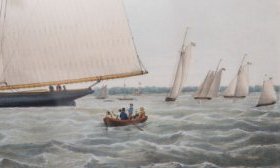 La goélette America TS Robins The picture by T S Robins, in which some of the yachts are clearly identifiable from their racing flags, may represent the part of the race after America passed Volante to take the lead but before Volante stood for the Nab Light vessel. Several yachts followed Volante so increasing the distance sailed; the rest followed America. Race card and race instructions apparently differed, one just saying Round the Isle of Wight while the other contained the normal Queen’s Course instruction to round the Nab. |
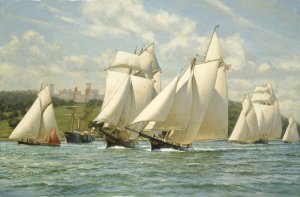 Aurora, Beatrice and America pass Osborne House AD Blake The racing yachts pass Osborne House, Queen Victoria's residence on the Isle of Wight. The Queen's Royal yacht, "Victoria and Albert I" is just leaving her mooring, close beneath Osborne House. To windward of "America" is the 47 ton cutter "Aurora" (second yacht to finish after "America") and the 161 ton schooner "Beatrice". Just astern of "America" is the small white cutter, "Wildfire", (an unofficial starter because she carried moveable sand bags of ballast- but actually finished the race ahead of "America") the large 218 ton schooner "Constance" and the 60 ton cutter "Freak". The 48 ton cutter "Volante" and the 160 ton schooner "Gypsy Queen" are leading the race, just ahead of this fleet. |
 The America Overtaking the Aurora Shirley Bicke'l Evans The crucial moment when Aurora continues its course to pass the lighthouse Neb., following Gypsy Queen Volante and then as America bear away to go inside the lighthouse, thus gaining a few miles and taking the lead. Protests from English, the Americans responded that the sailing instructions were not clear, the British bowed. (Note: Yachts are not on the good tack) |
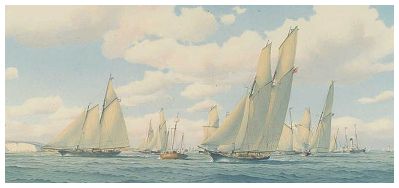 Le passage du phare Nab
Le passage du phare NabThe picture by T S Robins, in which some of the yachts are clearly identifiable from their racing flags, may represent the part of the race after America passed Volante to take the lead but before Volante stood for the Nab Light vessel. Several yachts followed Volante so increasing the distance sailed; the rest followed America.
Race card and race instructions apparently differed, one just saying Round the Isle of Wight while the other contained the normal Queen’s Course instruction to round the Nab.
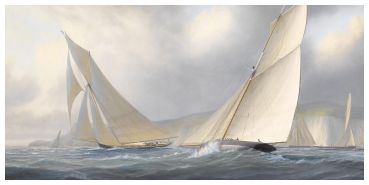 The America speedily advanced to the front and got clear away from the rest. Off Sandown Bay, the wind freshening, she carried away her jib-boom but, as she was well handled, the mishap produced no ill-effect, and, during a lull which came on in the breeze for some time subsequently, her competitors gained a trifling advantage, but did not approach her. Off Ventor the America was more than a mile ahead of the Aurora, then the nearest of the racing squadron; and hereabouts the number of her competitors was lessened by three cutters, the Volante having sprung her bowsprit, the Arrow having gone ashore, and the Alarm having stayed by the Arrow to assist in getting her off.
The America speedily advanced to the front and got clear away from the rest. Off Sandown Bay, the wind freshening, she carried away her jib-boom but, as she was well handled, the mishap produced no ill-effect, and, during a lull which came on in the breeze for some time subsequently, her competitors gained a trifling advantage, but did not approach her. Off Ventor the America was more than a mile ahead of the Aurora, then the nearest of the racing squadron; and hereabouts the number of her competitors was lessened by three cutters, the Volante having sprung her bowsprit, the Arrow having gone ashore, and the Alarm having stayed by the Arrow to assist in getting her off.
But from the moment the America had rounded St. Catherine's point, with a moderate breeze at S. S. W., the chances of coming up with her again were over. The Wildfire, which, though not in the match, kept up with the stranger for some time, was soon shaken off, and of the vessels in the match, the Aurora was the last that kept her in sight, until, the weather thickening, even that small comfort was lost to her.
As the America approached the Needles the wind fell, and a haze came on, not thick enough, however, to be very dangerous ; and here she met and passed (saluting with her flag) the Victoria and Albert royal yacht, with Her Majesty on board. Her Majesty waited for the Aurora, and then returned to Osborne, passing the America again in The Solent.
Result:
1. America 20:37
2. Aurora 20:45
3. Bacchante 20:30
4. Eclipse 21:45
5. Brillant 01:20 le samedi
About six o'clock the Aurora, being some five or six miles astern, and the result of the race inevitable, the steamers that had accompanied the yachts bore away for Cowes, where they landed their passengers. The evening fell darkly, heavy clouds being piled along the northern shore of the strait ; and the thousands who had for hours lined the southern shore, from West Cowes long past the Castle, awaiting anxiously the appearance of the winner, and eagerly drinking in every rumor as to the progress of the match, were beginning to disperse, when the peculiar rig of the clipper was discerned through the gloom, and at 8 h. 34 m. o'clock (railway time 8 h. 37 m., according to the secretary of the Royal Yacht Squadron) a gun from the flag-ship announced her arrival as the winner of the cup. Yankee Doodle was played by the band. The Aurora was announced at 8 h. 58 m.; the Bacchante at 9 h. 30 m.; the Eclipse at 9 h. 45 m.; the Brilliant at 1 h. 20 m. (Saturday morning).
No account of the rest.
Mr. Ackers, owner of the Brilliant, protested the race, on the ground that the America went inside, instead of outside the Nab light-vessel. As no instructions regarding the passing of this point were contained in the sailing directions given Commodore Stevens, the committee which heard Mr. Ackers' complaint dismissed it, and the cup went to the America.
